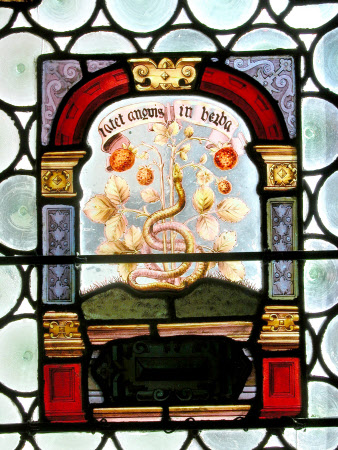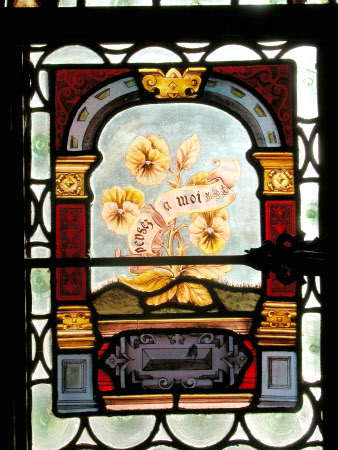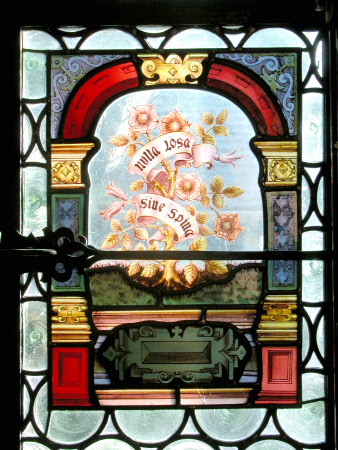Stained glass
Charles Eamer Kempe (Sussex 1837 - London 1907)
Category
Stained glass
Date
1888
Materials
Stained glass
Measurements
350 mm (H); 250 mm (W)
Place of origin
England
Order this imageCollection
Wightwick Manor, West Midlands
NT 1288915
Caption
In 1887, the Wolverhampton paint and varnish manufacturer Theodore Mander (1853–1900) and his wife Flora (1857–1905) designed their house, Wightwick Manor, as an exemplar of the so-called Aesthetic Movement. Its glorious late Victorian interiors remain some of the most complete examples of their type. Theodore patronised the celebrated stained- glass designer Charles Eamer Kempe (1837– 1907), whom he invited to stay at Wightwick, and who created these four glass panels. Kempe was part of the Aesthetic Movement, which celebrated ‘art for art’s sake’, and his inventive designs were influenced by medieval stained glass. Like many Victorian designers, he was interested in the symbolism of flowers, and the main panels depict four blooms, each with a text in Latin or French: a lily, flos castitatis (flower of chastity); a strawberry plant with fruit and a snake, latet anguis in herba (snake in the grass); a pansy, pensez à moi (think of me); and a rose, nulla rosa sine spina (no rose without a thorn). Installed at the top of the original main staircase in 1888, the panels filled this part of the house with a diffused glow of coloured light.
Summary
Four stained glass panels commissioned from the workshop of Charles Eamer Kempe (1837-1907) for installation in the newly built Wightwick Manor in 1888. Each panel depicts a flowering or fruiting plant - lily, strawberry, pansy and rose - set within a richly coloured and Renaissance inspired arched aedicule incorporating strapwork details. Banners are inscribed with inscriptions relating to the symbolism of the plant or flower. The panels are set in the Gothic traceried window designed to light the staircase and now forming part of the corridors serving the Family Wing. The wider window lights are made up of plain, leaded bull’s eye glass.
Full description
As built in 1887-8 to the design of Edward Ould (1852-1909), Wightwick Manor incorporated a staircase off the hall which was lit at first floor level by a large window with the most elaborate tracery of the whole house. Within this were set, from the beginning, four depictions of flowering or fruiting plants in stained glass commissioned from Charles Eamer Kempe (1837-1907). The window, complete with its glass, stayed in place when the staircase was removed during enlargement of the house in 1893 and it now lights part of the corridors serving the Family Wing. Glass by Kempe, who was inspired by late mediaeval and renaissance design and had a large and successful workshop, is to be found in churches across Britain and further afield but domestic work like that at Wightwick, where it was installed in both the 1887 and 1893 parts of the house, is much rarer. It thus ranks as one of his most significant commissions and all the more so for surviving essentially unaltered. Theodore (1853-1900) and Flora (1857-1905) Mander, Kempe’s patrons at Wightwick, were keen proponents of the Aesthetic Movement and had deep religious faith. Their fondness for colour, pattern and detail characteristic of late Victorian ‘artistic’ taste remains especially evident in the stained glass, which has not, unlike other elements of the collection, been subject to fading or darkening over time. It is also clear that the subject matter for such a prominent window, which would be seen by all those using the principal staircase, was carefully chosen and that the glass, as well as being beautiful, was intended to encourage religious and moral contemplation in the observer. The panels are placed in the principal lights of the window, at eye level to what would have been the head of the staircase. From the left, the first panel depicts the Madonna Lily, inscribed ‘flos castitatis’ (flower of chastity) and thus relating the lily to the Virgin Mary. The second panel incorporates a strawberry plant bearing fruit and intertwined by a snake. The motto reads ‘latet anguis in herba’ (snake in the grass). Strawberries were a medieval symbol of temptation and the snake therefore represents the serpent from the Garden of Eden. The third panel makes explicit the contemplative intention of the glass, using French instead of Latin for the inscription - ‘pensez a moi’ (think on me). These words are wrapped around pansies, which represent thought. The final panel bears a rose bush and on the banner are the words ‘nulla rosa sine spina’, ‘no rose without a thorn’. This panel is another direct reference to the Virgin Mary, as the mystic rose. The panels are set within plain, bull’s eye leaded glass and in the foils at the head of the lights is further stained glass depicting peacocks and eagles, considered sacred birds. Above are mouchette roundels incorporating daisies, for purity, oak leaves and acorns, for strength and endurance, and carnations, for divine love.
Provenance
Designed for Wightwick and installed in 1888.
Credit line
Wightwick Manor, the Mander collection (National Trust)
Marks and inscriptions
Flos Castitatis (Lily).
Makers and roles
Charles Eamer Kempe (Sussex 1837 - London 1907), artist
References
Ponder 1993: Stephen Ponder, Wightwick Manor, National Trust, London, 1993, pp.24-5 & 34-7 Barlow 2018: Adrian Barlow, Kempe: The Life, Art and Legacy of Charles Eamer Kempe, The Lutterworth Press, Cambridge, 2018., pp.245-7 Barlow 2019: Adrian Barlow, Espying Heaven: The Stained Glass of Charles Eamer Kempe and his Artists, The Lutterworth Press, 2019., pp. 22-3, 37 & 68-9



